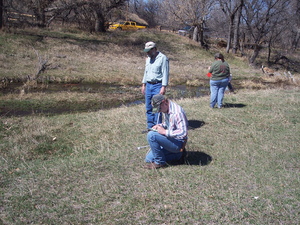Chadron Creek project gains national recognition

CHADRON, Neb. -- Nearby Chadron Creek may not represent a large piece of United States geography, but a project spearheaded by Chadron State College science students and faculty is “putting it on the map” and relaying its importance.
The Chadron-based resource partnership, “P3,” is garnering national attention for proposing sustainable use of fire-impacted resources in the Chadron Creek watershed. The group, which consists of Chadron State students and partners in the surrounding community, has been selected to compete against teams from about 40 other colleges and universities at the annual Sustainable Design Conference in Washington, D.C., in April 2008. The event is sponsored by the Environmental Protection Agency.
P3 is part of a national effort started by the EPA. Its name is shorthand for “People, Prosperity and the Planet.” The project at Chadron State is being led by student Jennifer Balmat and Dr. Mike Leite, CSC geoscience professor.
“This is a huge honor for our college,” Balmat said. “Not many small schools get a chance to compete in the P3 program. And it’s an excellent opportunity for undergraduates to participate in research.”
Members of the group are developing partnerships in the region affected by the Chadron Creek watershed. They hope to bring together members of the community affected by natural resources of the Chadron Creek drainage, which Leite said includes “just about anything.”
Chadron Creek begins near the top of the Pine Ridge about 12 miles south of Chadron and converges with the White River a few miles west of the city after it descends about 1,000 feet in elevation. Much of the watershed was burned during the wildfires of 2006.
Leite said the creek flows into the White River at just two to five cubic feet per second for much of the year, and at times runs dry before it reaches that point. The creek flows through the Chadron City Reservoirs, which are used as a community water supply and for recreation.
Despite Chadron Creek’s diminutive attributes, the P3 group is finding its worth far exceeds its face value.
“When you start listing the resources that are available to the community as a result of Chadron Creek, the list gets very long,” Leite said. “When you consider the needs of agriculture and community water supply alone, it’s clear that little creek makes life here possible.”
Leite said Chadron Creek relies heavily on underground water sources, picking up water from springs and small tributaries along its northward path.
“The Ogallala, or High-Plains, aquifer plays a central role in Chadron Creek’s existence,” Leite said. “Water sources such as Chadron, Bordeaux, Dead Horse and Ash creeks are there as a result of the aquifer leaking out of the Pine Ridge. The streams flow during the summer because of springs fed by the aquifer. Their fate, and that of our water supply, depends on the availability of ground water up on the Table (the relatively flat land at the top of the Pine Ridge).”
Balmat said the P3 group is seeking ways for citizens of the region to communicate among themselves about natural resources.
“We are trying to understand a resource that is vital to this community, so it is important for the community to become involved in this process,” she said.
Members have made contact with people living along the creek, and conduct quarterly water-quality surveys on their land. The findings are part of an ongoing record of the water resource in the creek itself. The group is looking to expand contacts with landowners.
The P3 group’s meetings are open to the public each Friday at 4 p.m. in CSC’s Math and Science Building. In addition, community members will be invited to share input during public receptions.
The P3 award competition is in conjunction with the EPA’s annual Sustainable Design Expo, at which exhibitors demonstrate the possibilities of innovative designs to simultaneously benefit people, bring economic prosperity and protect the planet. The national competition enables college students to research, develop and design scientific, technical and policy solutions to sustainability challenges. Winning designs can receive additional funding of up to $75,000 to help bring the designs to the marketplace or implement them in the field.
Pronunciations:
Balmat: Bal rhymes with Al, matt
Leite: Lighty
Category: Campus Announcements, Campus News
